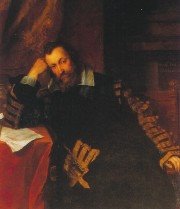Friday, 11 May 2007
Kenelm Digby - alchemist, mathematician, eccentric
* * *
Kenelm Digby
Sir Kenelm Digby (July 11, 1603 – June 11, 1665) was born at Gayhurst, Buckinghamshire. He was of gentry stock, but his family's adherence to Roman Catholicism coloured his career. His father, Sir Everard, was executed in 1606 for his part in the Gunpowder Plot.
* * *
Early life and career
He went to Gloucester Hall, Oxford in 1618, but left without taking a degree. He spent three years in Europe between 1620 and 1623, where Marie de Medici fell madly in love with him (as he later recounted). He married circa 1625 Venetia Stanley.
He had also become a member of the Privy Council of Charles I of England. His Roman Catholicism being a hindrance in the way of government office, he switched to Anglicanism.
* * *
In 1628, Digby became a privateer, with some success.
He returned to become a naval administrator and later Governor of Trinity House.
* * *
His wife died suddenly in 1633, prompting a famous deathbed portrait by Van Dyck and a eulogy by Ben Jonson. (Digby was later Jonson's literary executor. Jonson's poem about Venetia is now mostly lost, because of the loss of the center sheet of a leaf of papers which held the only copy.)
Digby, stricken with grief and the object of enough suspicion that the Crown had ordered an autopsy (rare at the time) on Venetia's body, secluded himself in Gresham College and attempted to forget his personal woes through scientific experimentation and a return to Catholicism.
* * *
Character and works
Digby was regarded as an eccentric even by his contemporaries, partly because of his effusive personality, and partly because of his interests in scientific matters. He lived in a time when scientific enquiry was very much in the air, but had not settled down in any disciplined way, or broken completely with earlier ideologies.
He is credited with being the first person to note the importance of "vital air," or oxygen, to the sustenance of plants.[1] Yet he also spent enormous time and effort in the pursuits of astrology and alchemy (as indeed would others of his era, like the noted alchemist Sir Isaac Newton).
* * *
Notable among his pursuits was the concept of the Powder of Sympathy. This was a kind of sympathetic magic; one manufactured a powder using appropriate astrological techniques, and daubed it, not on the injured part, but on whatever had caused the injury. Synchronising the effects of the powder, which apparently caused a noticeable effect on the patient when applied, was actually suggested in 1687 as a means of solving the longitude problem.
* * *
He was in touch with the leading intellectuals of the time, and was highly regarded by them; he was a founding member of the Royal Society and a member of its governing council from 1662 to 1663.
His correspondence with Fermat contains the only extant mathematical proof by Fermat, a demonstration, using his method of descent, that the area of a Pythagorean triangle cannot be a square.
* * *
Digby is known for the publication of a cookbook, The Closet of the Eminently Learned Sir Kenelme Digbie Knight Opened, but it was actually published by a close servant, from his notes, in 1669, several years after his death. It is currently considered an excellent source of period recipes, particularly for beverages such as mead.
* * *
Digby is also considered the father of the modern wine bottle. During the 1630s, Digby owned a glassworks and manufactured wine bottles which were globular in shape with a high, tapered neck, a collar, and a punt. His manufacturing technique involved a coal furnace, made hotter than usual by the inclusion of a wind tunnel, and a higher ratio of sand to potash and lime than was customary. Digby's technique produced wine bottles which were stronger and more stable than most of their day, and which, due to their dark color, protected the contents from light. During his exile and prison term, others claimed his technique as their own, but in 1662 Parliament recognized his claim to the invention as valid.
[edit] See also
* A short extract from one of Digby's books on alchemy
[edit] Note
1. ^ The Cambridge History of English and American Literature, Vol. VIII.
[edit] External links
* Works by Kenelm Digby at Project Gutenberg
* Digby's Observations upon Religio Medici
* The Extraordinary Streetfight of Kenelm Digby, The Association of Rennaissance Martial Arts
[edit] Further reading
* Bligh, E W: Sir Kenelm Digby and his Venetia
* Fulton, John Farquhar: Sir Kenelm Digby; writer bibliophile & protagonist of William Harvey
* Peterson, R T: Sir Kenelm Digby
* Digby, Roy: Digby: The Gunpowder Plotter's Legacy ISBN 1-85756-520-7
Retrieved from "http://en.wikipedia.org/wiki/Kenelm_Digby"
http://en.wikipedia.org/wiki/Kenelm_Digby
* * *
Subscribe to:
Post Comments (Atom)

No comments:
Post a Comment